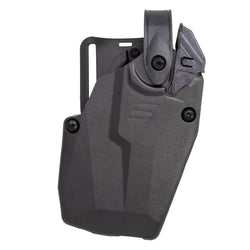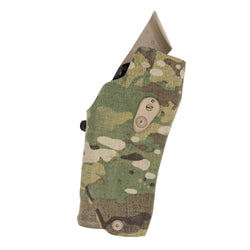In my United States Marine Corps days, the vast majority of our live-fire training was on static firing lines, or we had very regimented movements to follow. As the Global War on Terrorism went on, the entire U.S. Military adopted a new firearms training concept, competition to combat.
Safely and proficiently moving while manipulating a firearm is a complex skill—one that you will only learn while actually doing it. Learning to do so under stress is a whole other can of worms. Competitive shooting offers a viable path to build those essential handling skills, especially when paired with quality instruction from a good trainer.
Types of Handgun Competitions

In the United States, we have multiple types of handgun competitions, and you can find many of them right in your own state.
Some competitions require more physical movement, such as the International Defensive Pistol Association (IDPA) and United States Practical Shooting Association (USPSA), where you will actually move around a course of fire and engage multiple targets. Others are more precision-oriented types of competition, such as Precision Pistol and Action Pistol, where the focus is shifted more towards accuracy and consistency.

All of these competitions will help you expand your firearms proficiency while having fun at the same time. Who doesn’t like a day at the range?
Training vs. Application
In general, firearms training classes consist of a series of drills that you repeat multiple times. Repetition is good, but to become proficient, we need to apply it in the real world in some way. Thankfully, we don’t have to step outside and use force on a daily basis. Shooting competition gives us the chance to apply many of the skills we learn in a training class.
Competition shooting requires you to perform on command, under the stress of a timer, with no opportunity for a do over. That small amount of stress applied will cause you to make mistakes, and those mistakes are where we learn the most.
If you choose a competition like USPSA or IDPA, which requires you to navigate a course, you’ll build more advanced firearms handling skills over time. You will become proficient in the safe handling of your firearm as you move, reloading on the move, and acquiring your sights quicker to engage targets. Precision competitions will do just that: help you become more accurate with your handgun than you ever thought possible. You will push the limits of what people believe is possible for handgun accuracy.
Both types of competition have their place, and both will help you gain skills. I personally like to shoot both Action Pistol and USPSA as I feel it gives me the best of both sides of the competitive shooting experience.
Competition Shooting: Getting Started with Gear

Now that you’re giving competition shooting a look, what do you need to get started? The good news here is that you likely already own what you need.
For most matches, there is a production or production optics division where your everyday carry firearm will work just fine. The production divisions generally are based on the various striker-fired handguns, with or without a reflex sight. All of these competitions also make room for those of us who love our wheelguns and 1911s, so us old guys won’t be left out.
In addition to your firearm, you will need a few spare magazines or speedloaders and a way to carry them, along with a suitable holster for your gun.
Your First Match Experience
Everyone is a little nervous about their first match, and with good reason. You are about to do something you have never done before that involves a small, controlled explosion two to three feet in front of your face. But here’s the key: all you need to worry about at your first match is being safe. Don’t worry about where you finish, how well you do, or setting any world records.
Arrive early, introduce yourself, and help set up the match. Find one of the range officers and let them know it’s your first match. At these events, you will find that most people are eager to help you and want to get you involved. Just be safe, relax, and have fun.
Stress, Growth, and Learning
The stress and nervousness you’ll feel in competition is minuscule compared to an actual use-of-force situation, but it is, in fact, helping you. The mistakes you make shooting a course of fire in a match give you something to work on in training.
As you continue to shoot competitions, you will begin to eliminate these mistakes and refine your skills. You will work through marksmanship, movement, gun handling, and more at every match. As your skills advance, you’ll uncover new areas to focus on, because we are never done learning!
After you get a few matches under your belt, the nervousness will fade. Your firearms manipulation will improve, and you will likely have a desire to advance in your chosen competition.
Final Thoughts

As you invest more time in the sport, you will likely start acquiring firearms and gear that better fit your chosen division. You will practice more, steadily advancing your skills—and all of that combined is what your initial defensive pistol instructor was telling you to do.
We all need to strive to practice and train as much as possible to be more proficient with our firearms, should that awful bump in the night situation occur. Competition shooting is one huge part of the training puzzle that will help you become more proficient in using your firearm.









